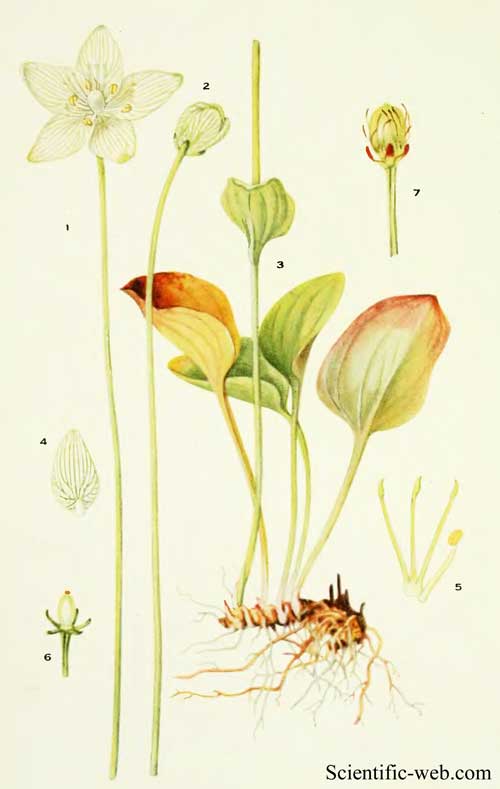
Parnassia caroliniana
Classification System: APG IV
Superregnum: Eukaryota
Regnum: Plantae
Cladus: Angiosperms
Cladus: Eudicots
Cladus: Core eudicots
Cladus: Rosids
Cladus: Eurosids I
Ordo: Celastrales
Familia: Celastraceae
Subfamilia: Parnassioideae
Genus: Parnassia
Sectio: P. sect. Parnassia
Species: Parnassia caroliniana
Name
Parnassia caroliniana Michx., Fl. Bor.-Amer. 1: 184. 1803.
Synonyms
Parnassia floridana Rydb.
Parnassia grandiflora Rafin.
Parnassia ovata Muhl.
Parnassia speciosa Hort. ex W. Baxt.
Distribution
Native distribution areas:
Continental: Northern America
Regional: Southeastern USA
USA (Florida, North Carolina, South Carolina)
References: Brummitt, R.K. 2001. TDWG – World Geographical Scheme for Recording Plant Distributions, 2nd Edition
References
Primary references
Michaux, A. (1803) Fl. Bor.-Amer. 1: 184.
Links
Hassler, M. 2019. Parnassia caroliniana. World Plants: Synonymic Checklists of the Vascular Plants of the World In: Roskovh, Y., Abucay, L., Orrell, T., Nicolson, D., Bailly, N., Kirk, P., Bourgoin, T., DeWalt, R.E., Decock, W., De Wever, A., Nieukerken, E. van, Zarucchi, J. & Penev, L., eds. 2019. Species 2000 & ITIS Catalogue of Life. Published online. Accessed: 2019 October 05. Reference page.
Govaerts, R. et al. 2019. Parnassia caroliniana in Kew Science Plants of the World online. The Board of Trustees of the Royal Botanic Gardens, Kew. Published online. Accessed: 2019 October 05. Reference page.
International Plant Names Index. 2019. Parnassia caroliniana. Published online. Accessed: October 05 2019.
Tropicos.org 2019. Parnassia caroliniana. Missouri Botanical Garden. Published online. Accessed: 05 October 2019.
USDA, ARS, Germplasm Resources Information Network. Parnassia caroliniana in the Germplasm Resources Information Network (GRIN), U.S. Department of Agriculture Agricultural Research Service. Accessed: 08-Apr-12.
Wunderlin, R.P. & Hansen, B.F. 2008. Parnassia caroliniana in Atlas of Florida Vascular Plants. Institute for Systematic Botany, University of South Florida, Tampa. Published online. Accessed: 2015 Aug 30.
Vernacular names
English: Carolina grass of Parnassus
Parnassia caroliniana is a species of flowering plant in the Celastraceae known by the common name Carolina grass of Parnassus. It is native to the southeastern United States, where it occurs in North Carolina and South Carolina, with an isolated population in the Florida Panhandle.[1][2][3]
This rhizomatous perennial herb grows up to 65 centimeters (26 inches) tall. The basal leaves have rounded to oval blades borne on long petioles and leaves on the stem are heart-shaped and clasp the stem at their bases. The inflorescence is a solitary flower with five deeply veined white petals which may exceed 2 centimeters (0.8 inches) in length. At the center are five stamens with yellow anthers and five three-parted staminodes. The fruit is a capsule.[2]
Parnassia caroliniana grows in moist areas in a variety of habitat types, including flatwoods, savannas, bogs, and the ecotones between pocosins and savannas or swamps and savannas. On the coastal plain the plant can be found on sandy calcareous substrates with peat. The plant is "always associated with pines," such as longleaf pine and slash pine.[2] These may be found on pine plantations. Many of the healthiest occurrences of the plant are located on land owned by timber companies. Other plants in the habitat may include Andropogon virginicus, A. glomeratus, Aristida stricta, Arundinaria tecta, Centella asiatica, Ctenium aromaticum, Dichromena sp., Erigeron vernus, Eryngium integrifolium, Eupatorium rotundifolium, E. leucolepis, E. pilosum, Fothergilla gardenii, Gaylussacia frondosa, Gentiana pennelliana, Helenium pinnatifidum, Ilex glabra, Lorinseria areolata, Lyonia lucida, Pinus serotina, Platanthera ciliaris, P. cristata, Pteridium aquilinum, Ptilimnium capillaceum, Pycnanthemum flexuosum, Rhexia alifanus, Sarracenia flava, S. purpurea, Taxodium ascendens and Vaccinium crassifolium.[2]
The main threats to the species come from activities related to timber, such as logging, planting of seedlings, and ditching. Once trees are established, fire suppression is practiced in the area. This prevents a natural fire regime that would normally keep the forests and woodlands clear of brush and maintain an open canopy. The land is also drained, making it too dry to support the plant. Land is also lost in the conversion to residential and commercial development.[2]
This plant is being conserved at Moores Creek National Battlefield in North Carolina, where wetland rehabilitation is in progress.[1]
References
Parnassia caroliniana. Archived 2011-10-26 at the Wayback Machine Center for Plant Conservation.
Parnassia caroliniana. The Nature Conservancy.
Biota of North America Program 2014 county distribution map
Retrieved from "http://en.wikipedia.org/"
All text is available under the terms of the GNU Free Documentation License

